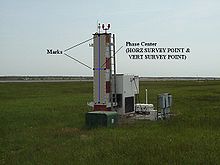Microwave landing system
The Microwave Landing System ( MLS ) microwave landing system is a landing aid for aircraft that sends positioning signals in the range of 5 GHz. It was originally intended (in the 1980s) as a successor system to the instrument landing system ILS , which works in the VHF range. The International Civil Aviation Organization standardized the procedure in 1984. The successor decision was suspended in 1995 because GPS -based systems promised a more cost-effective alternative. Compared to the instrument landing system, the MLS primarily offers the advantage that the approach course and glide path can be freely selected. This means that segmented or curved approaches are also possible.
functionality
A tightly bundled beam irradiates the approach area in a horizontal and vertical plane. The MLS receiver in the aircraft determines when it is detected by the ground-based transmitter. The start time is known from the preamble , which, like other general data, is transmitted in all directions. The receiver calculates the position to the runway or to the glide path from the time intervals between the forward and backward running beam . The azimuth antenna also transmits data (azimuth track, minimum approach angle, additional e.g. condition of the runway, wind shear or weather ). DME / P supplies the distance component in order to determine the position in space together with the two angles. The precision version of the Distance Measuring Equipment ( DME / P ) is part of the MLS. However, the DME / P also satisfies the compatibility requirement with the standard DME. The higher precision of the DME / P may result. a. from an increased edge steepness of the envelope curve of the query and response pulses. This enables the impulse start times to be determined more precisely in DME / P systems.
MLS offers 200 transmission channels, ILS only 40.
Signal properties
- Time Reference Scanning Beam (TRSB)
- Frequency: 5030 to 5091 MHz
- Distance fraction: DME / P
- Backazimuth , d. H. also for missed approach
- Multipath, curved & segmented approach

